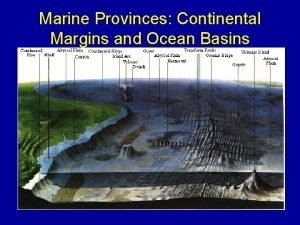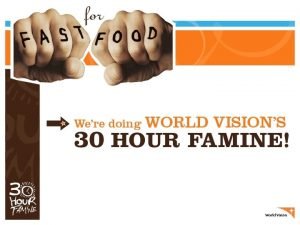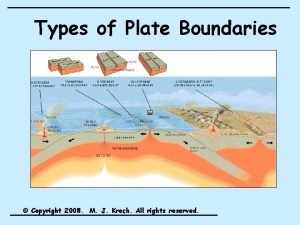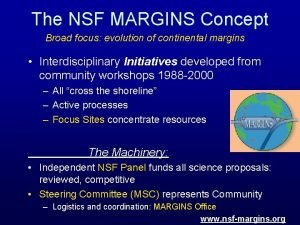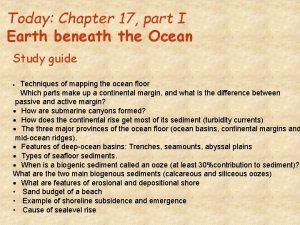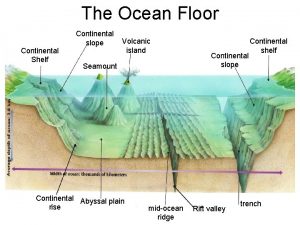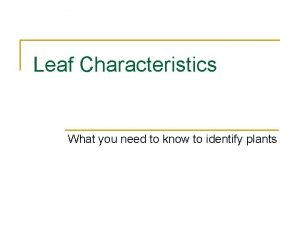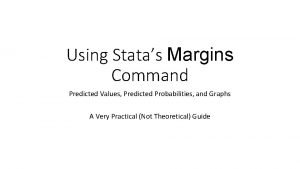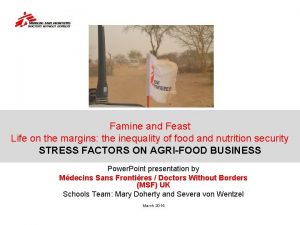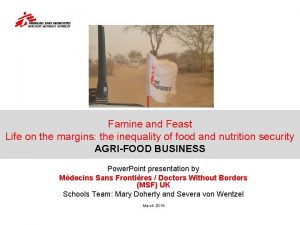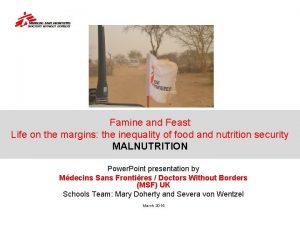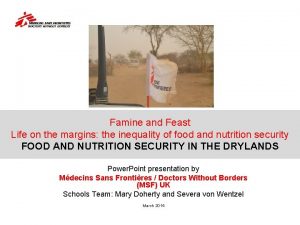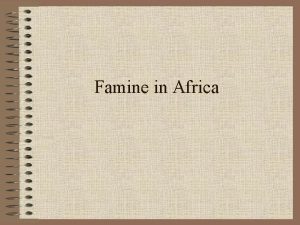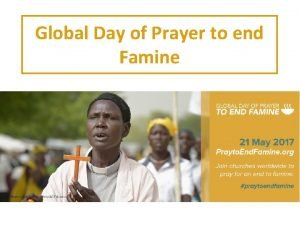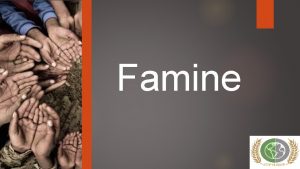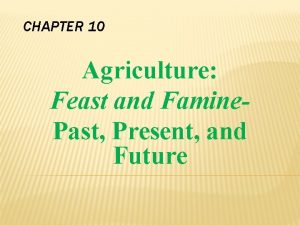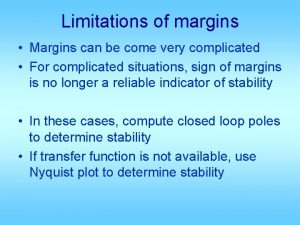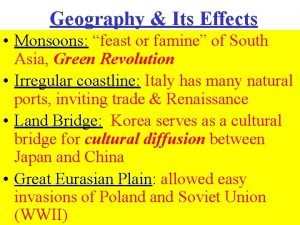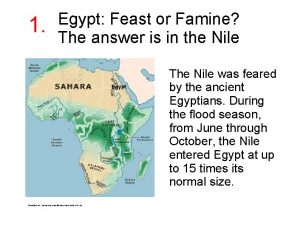Famine and Feast Life on the margins the


















- Slides: 18

Famine and Feast Life on the margins: the inequality of food and nutrition security THINKERS’ VIEWS ON FEEDING GROWING POPULATIONS Power. Point presentation by Médecins Sans Frontières / Doctors Without Borders (MSF) UK Schools Team: Mary Doherty and Severa von Wentzel March 2014

Image: http: //www. southdacola. com THE THINKERS’ VIEWS ON FEEDING GROWING POPULATIONS

Global population in billions Population explosion? The claim that population was exploding was not exaggerated. Population growth has been exponential, not linear, and resources are finite. Does more people meant more poorer people? Actually, it matters not only what new people cost, but also what they can add. Images http: //www. census. gov/population/international/data/idb/images/worldgr. png http: //debitage. net/humangeography/population. html

Global population growth rates Action for students: Although the population in absolute numbers continues to grow, the growth rates have slowed down. How can both be happening? Watch the Population Reference Bureau’s Video “ 7 billion and counting” http: //www. prb. org/Publications/Datasheets/2011/world-population-data-sheet/video-7 -billion. aspx K Images http: //www. census. gov/population/international/data/idb/images/worldgr. pnghttp: //www. census. gov/population/international/data/idb /images/worldgr. png http: //debitage. net/humangeography/population. html

Does ‘population explosion’ lead to famine? Action for students: 1. Work in a group of four and study each of the graphs etc on the previous slide separately, discuss and agree what each one shows and also agree a written conclusion for each. What is the role of population pressure in creating food insecurity? Take into account how population numbers, densities and rates of growth impact on the adequacy of food production. 2. Use the world map and key to identify the highest rate of increase of population and the lowest. Take into account net migration, a fundamental component of population growth along with natural increase. 3. Discuss what drives these rates and whether they lead to famine. Further info: Multimedia resource on population trends and correlations – http: //www. 7 billionactions. org/data? gclid=CK-ql. ZCs 8 rc. CFa 7 Jt. Aod 5 yk. AOA On population growth and food production – the looming food crisis in Asia: http: //www. youtube. com/watch? v=5 UKp. QKOjids

Famine: the thinkers Supply approach (1) “No possible form of society could prevent the almost constant action of misery upon a great part of mankind” - Thomas Malthus (1798) Image: http: //www. makara. us/04 mdr/ 01 writing/03 tg/bios/Malthus_f iles/Thomas. Malthus 3. jpg • For Thomas Malthus “An Essay on the Principle of Population”: (1789) - supply approach - the growth of population causes more food demand, while the food supply is limited. • A rapidly increasing population could not be matched by growth in food supply, so could result in famine or possibly lead to civil war. • Since the 18 th century the world population has grown from 1 billion to 6. 6 billion. During this time food production and living standards have risen. • Written prior to industrialisation and modern technology • Critiqued as static world view.

Famine: the thinkers Supply approach (2) K Malthus theory (1826) • Horizontal scale = time • Vertical scale = volume of food production and consumption. Source: http: //debitage. net/humangeography/populat ion. html

Neo-Malthusian Neo-pessimists (1) The neo-Malthusians have been predicting global famine because of an overpopulated planet. In The Population Bomb (1968) Dr. Paul Ehrlich pronounced: “The battle to feed all humanity is over. ” In the 1970 s the concept of a global food crisis, the Malthusian catastrophe, took hold with concerns that there would not be enough food to feed the growing world population. Based on the Malthusian premise, the people in development with power implemented neo-Malthusian policies and aid focused on increasing food supply and containing population growth through population control. http: //en. wikipedia. org/wiki/ File: Paul_Ehrlich__1974. jpg

Neo-Malthusian Neo-pessimists (2) • Paul Ehrlich argues that the increased agricultural and industrial activity needed to feed the population will lead to environmental and economic disaster. – “A dying planet” – “Too many people” – “Too little food” – “Environmental degradation”* • Neo-Malthusians predict a crisis of food, energy water and land resources. “Solving the population problem is not going to solve the problems of racism…of sexism…of religious intolerance… of war… of gross economic inequality. But if you don’t solve the population problem, you’re not going to solve any of those problems. Whatever problem you’re interested in, you’re not going to solve it unless you also solve the population problem. ”(http: //www. populationmatters. org/making-case/quotations/) * Ehrlich quoted in Weeks, J R (1999) Population: An Introduction to Concepts and Issues 7 th Edition pp 673 Belmont, CA: Wadsworth

Global population and food supply K Action for students: Do you think Malthus’s ideas were correct? If not for food, do they hold for water? Did the Industrial Revolution debunk his theory? Graph: http: //www. tasteofsustainability. com/wp-content/uploads/2012/02/2050 global-population-and-food-supply 1. jpg

The innovators technocentric model PHOTO: JAN JØRGENSEN /SCANPIX Boserup Ester Boserup argued that societies under pressure from population growth invent their own technologies to increase food production. • More people means that existing land must be farmed more extensively. • Long fallow is replaced with short fallow periods. • More labour is required for farming. • Forests became grasslands requiring the application of nutrients and the turning of the soil. • Men cleared the land women grew the food • Women weeded the fields to enable the use of short fallow periods • Increased population led to more intensive agricultural systems using animals to pull ploughs • Common land was substituted for private ownership

Malthus. Population growth versus . Boserup Population growth Increased food demand Less food Per capita Improved agricultural productivity Positive checks Increased mortality Preventive checks Decreased fertility Reduction in population growth Population growth Food per capita falls Negative feedback loop Food supply Agricultural capital Population growth continues Source: Adapted from Witherick M. And S. Warn Farming, Food and Famine, Nelson Thornes: 2001

Amaryta Sen – the capability approach Amaryta Sen wrote on poverty, famines and deprivation based on the 1943 famine in Bengal, India. He argued that Image: the cause was “entitlement failure” against the Food Availability http: //scholar. harvard. edu/sen Decline (FAD) hypothesis. FAD holds that the central cause of all famines is a decline in food availability. His approach has been influential in the trade justice and sustainability discourse. “I attempted to see famines as broad "economic" problems (concentrating on how people can buy food, or otherwise get entitled to it), rather than in terms of the grossly undifferentiated picture of aggregate food supply for the economy as a whole. ” – Sen in his book Poverty and Famines (1981) • Sen argued famine occurs not only from lack of food, but from inequalities built into mechanisms for distributing food • Sen points to a number of social and economic factors, e. g. declining wages, unemployment, rising food prices, and poor food distribution systems which lead to starvation amongst certain groups in society (the landless labourer or urban service providers like hair cutters) Further info on different approaches http: //www. academia. edu/1909449/Food_Security_and_Entitlement_A_Critical_Analyses

Stephen Devereux International Development Institute Critique by Stephen Devereux (IDS): “Sen’s Entitlement Approach – Critiques and Counter-critiques” Image http: //www. ids. ac. uk/person/stephe n-devereux “A complementary analysis is required, one that recognizes the importance of non-market institutions in determining entitlements, famine as social process and epidemiological crisis, and violations of entitlement rules in the complex emergencies that typify most contemporary famines. ”(http: //www. sas. upenn. edu/~dludden/Famine. Mortality. pdf) The issues of food security has broadened beyond the economics perspective and the Individual as a unit of analyses. It includes: – political regime, – natural disaster, – civil war, – local and global governance, – climate change and – environmental issues (Devereux 2000).

Population growth and environmental scarcity Thomas F. Homer Dixon argues that a global population expected to pass 8 billion in 2025 and rapid growth in the global economy exasperates depletion of resources and lead to profound social consequences. Countries with capable states, efficient markets and an educated population tend to adapt better to scarcity than those without these traits. Link to download the book http: //fevuneraby. 3 owl. com/2013/07/ download-ebookenvironmentscarcity-andviolence/ The effects of environmental scarcity are indirect and together with other socio-economic and political stresses can include: • Deepened poverty and sharpened inequality • Large-scale migrations • Weakened institutions • Forms of civil violence (e. g. , insurrections, ethnic clashes, urban unrest) • On-going turmoil and violence (E. g, Chiapas, Mexico; many African and Asian countries) Source and image: http: //press. princeton. edu/titles/6640. html)

Kalahandi syndrome: Famine in spite of plenty Is food security primarily determined by whether poor people have access to food? Famine is not usually caused by absolute scarcity but by inequity in the distribution of food production, the inability to produce food (lacking resources) and to import the shortfall (lacking means). As such, it is avoidable. Kalahandi Syndrome: Kalahandi district is major provider of rice to the India Food Corporation. The Syndrome describes cases where famines occur because farmers grow cash crops to meet demands of the global markets instead of feeding themselves, so famine linked more to uneven access to food, resources and technologies than ability to increase global agricultural production and aggregate food availability. Landless farmers could not afford to buy the rice they had grown from their landlords. Famine can occur in areas with low access to food infrastructure markets because of social and economic issues and / or low agricultural potential because of biophysical constraints rather than in areas favoured with high levels of both. Kalahandi district Source: http: //www. academia. edu/1909449/Food_Security_and_Entitlement_A_Critical_Analyses Devereux, S, 2000, “Famine in the twentieth century”, IDS working Paper, no 105, Intitule of Development Studies, Brighton. ____2001, “ Sen’s entitlement Approach: Critiques and Counter-critiques, Oxford Development Studies, Vol. 29, No. 3, pp. 245 -263 https: //www. securenutritionplatform. org/Pages/Display. Resources. aspx? RID=179 http: //www. slideshare. net/jvonbraun/emerging-issues-in-developing-countries-food-and-agriculture-challenges-for-policy-and-research Map: http: //upload. wikimedia. org/wikipedia/commons/d/d 5/Orissa. Kalahandi. png

MSF: Contact us or find out more Visit our website: www. msf. org. uk About MSF: http: //www. msf. org. uk/about. aspx Email us: schools@loondon. msf. org Find us on facebook: www. facebook. com/MSF. english Follow us on Twitter: www. twitter. com/MSF_UK Follow us on You tube: www. youtube. com/user/MSFUK The MSF movement was awarded the 1999 Nobel Peace Prize. Contents 17

 Feast and famine
Feast and famine Africa's economic systems comprehension check answer key
Africa's economic systems comprehension check answer key Georgia's judicial branch comprehension check
Georgia's judicial branch comprehension check Continental margin
Continental margin World vision 30 hour famine
World vision 30 hour famine Elijah famine
Elijah famine Ireland in 1729
Ireland in 1729 Mid atlantic ridge
Mid atlantic ridge Stata plot interaction effects
Stata plot interaction effects Undulate bacterial colony
Undulate bacterial colony Nsf margins
Nsf margins Mla format google drive
Mla format google drive What type of forces dominate at convergent plate margins
What type of forces dominate at convergent plate margins Apa times new roman
Apa times new roman Margins
Margins Continental slope
Continental slope Geometric unsharpness of margins in radiographic image
Geometric unsharpness of margins in radiographic image Fascicled leaf
Fascicled leaf Prevmar
Prevmar



